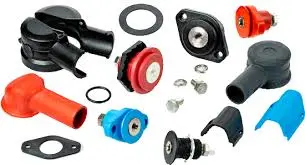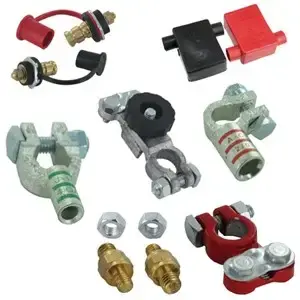Battery terminal connectors are vital in establishing a secure and efficient connection between a battery and an electrical system. These connectors serve as the crucial link that enables the battery to transmit power to various devices and equipment.
This comprehensive guide will explore the different types of battery terminal connectors available in the market and tips for choosing the correct connector for your specific needs. Additionally, we will delve into connecting battery terminals, providing you with a clear understanding of the steps involved.
Part 1. What are battery terminal connectors?
Battery terminal connectors are essential to create secure electrical connections between batteries and other devices or systems. Typically, manufacturers make these connectors out of conductive materials like copper or brass, which help facilitate the flow of electricity. They ensure that power flows smoothly from the battery to whatever it’s powering, whether a car, a flashlight, or a remote-controlled toy. These connectors come in different shapes and sizes. Still, all serve the same purpose of ensuring electricity can travel where it needs to go without interruptions. Without proper terminal connectors, batteries couldn’t power our favorite gadgets reliably.
Part 2. Battery terminal connector types: A detailed comparison (2025 Guide)
| Type | Best For | Materials | Pros | Cons |
|---|---|---|---|---|
| Post Terminal | Automotive, Marine | Copper, Brass | High conductivity, Easy installation | Prone to corrosion without coating |
| Lug Terminal | Industrial machinery, Solar systems | Copper, Aluminum | Heavy-duty clamping, High current capacity | Bulky size, Requires tools |
| Clamp Terminal | Battery testing, Jump-starting | Steel, Zinc alloy | Quick temporary connection, Adjustable jaws | Not for permanent use |
| Ring Terminal | Automotive wiring, Marine electronics | Tinned copper | Secure bolt-on connection, Corrosion-resistant | Limited to screw-type posts |
| Flag Terminal | Fuse boxes, Relays | Brass, Nickel-plated | Compact design, Easy insertion | Lower current rating |
| Splice Terminal | Wire joining, DIY projects | Copper, PVC insulation | Versatile, Insulated | Requires crimping tools |
1. Post Terminal Connectors for Automotive Use
Post terminals are the standard choice for car batteries, featuring a threaded stud that securely attaches to the battery terminal. They are widely used in automotive and marine applications due to their simplicity and reliability. Corrosion Tip: Apply anti-corrosion spray or grease to extend lifespan and prevent power loss.
2. Lug Terminals for Industrial Power Systems
Lug connectors are designed for heavy-duty applications, such as industrial machinery and renewable energy systems. Their U-shaped design allows for high current transmission (up to 300A), making them ideal for power-intensive setups.
Common Issue: Ensure proper torque (8-10 Nm) during installation to prevent loosening under vibration.
3. Clamp Terminals for Quick Connections
Clamp terminals, also known as alligator clips, are perfect for temporary connections like battery testing or jump-starting vehicles. Their spring-loaded jaws provide a quick and secure grip on battery terminals.
Maintenance Tip: Clean the jaws regularly to remove dirt and ensure a strong electrical connection.
4. Ring Terminals for Secure Wiring
Ring terminals are commonly used in automotive and marine wiring due to their circular design, which fits securely around a screw or stud. They are ideal for applications requiring a stable, long-lasting connection.
Installation Tip: Use a crimping tool to ensure a tight fit and avoid wire pull-out.
5. Flag Terminals for Compact Connections
Flag terminals, or blade terminals, are flat and rectangular, making them suitable for tight spaces like fuse boxes and relay panels. They are easy to install and remove, making them a favorite for automotive wiring.
Common Issue: Avoid over-tightening screws, as this can damage the terminal.
6. Splice Terminals for Wire Joining
Splice terminals are used to join two or more wires together, commonly found in electrical installations and DIY projects. They come in various types, including crimp-on, heat-shrink, and twist-on connectors.
Pro Tip: Use heat-shrink splice connectors for added insulation and durability in harsh environments.
Part 3. Tips for choosing battery terminal connectors
When selecting battery terminal connectors, it’s essential to consider the following factors:
- Application: Determine the specific application and electrical requirements for your project. Different applications may require different types of connectors to ensure compatibility and optimal performance.
- Material: Choose connectors made from high-quality materials such as copper or brass, which offer good conductivity and durability. Avoid connectors made from low-quality materials that may corrode or degrade over time.
- Wire Size: Consider the wire gauge or size used with the connector. Ensure the terminal connector is compatible with the wire size to establish a proper and secure connection.
- Environment: Assess the environmental conditions where you will use the connectors. Factors such as temperature, moisture, and exposure to chemicals or vibrations can affect the performance and lifespan of the connectors. Select connectors that are suitable for the specific environmental conditions.
- Ease of Installation: Choose connectors that are easy to install and provide a secure connection. Some connectors may require specialized tools or techniques for installation, so consider the available resources and expertise.
- Safety: Ensure that the selected connectors meet safety standards and regulations. Look for connectors with features like insulation, strain relief, and protection against short circuits or accidental disconnections.
Part 4. How are battery terminals connected?
Here’s a simple guide to connecting battery terminals:
- Preparation: Ensure that the battery and the electrical system are turned off or disconnected to prevent accidents or short circuits.
- Select the Connector Type: Choose the appropriate terminal connector based on the type of battery terminals and the application. Common types include top post connectors, side post connectors, ring terminals, and clamp connectors.
- Terminal Cleaning: Clean the battery terminals and connectors using a wire brush or terminal cleaner to remove any corrosion or dirt.
- Position the Connector: Place the connector over the battery terminal, ensuring it aligns correctly with its polarity (positive or negative).
- Secure the Connector: Use the provided hardware, such as bolts or screws, to secure the connector in place. Tighten the hardware securely to ensure a stable connection.
- Check the Connection: Once the connector is secured, gently tug it to ensure it’s firmly attached to the battery terminal. Verify that there are no loose connections or signs of instability.
- Test the Connection: After connecting the terminals, test the battery to ensure proper functionality. This may involve starting a vehicle, powering up a device, or using a multimeter to measure voltage.
Part 5. How to maintain battery terminal connectors?
Proper maintenance extends connector lifespan and prevents failures:
1. Corrosion Prevention
– Apply dielectric grease or petroleum jelly to terminals
– Use anti-corrosion washers (felt or synthetic)
– Avoid exposure to saltwater in marine environments
2. Regular Inspection
– Check monthly for:
• Loose connections (tighten to manufacturer specs)
• Cracked insulation
• Green/white powdery deposits
– Clean with baking soda solution (1 tbsp water : 1 tsp soda)
3. Environmental Protection
– Install rubber boots on automotive terminals
– Use heat-shrink tubing on exposed wires
– Store spare connectors in sealed containers
Part 6. FAQs about battery terminal connector types:
What is the L-type battery terminal?
The L-type battery terminal is shaped like the letter “L” and is commonly used in automotive and marine applications for secure electrical connections.
What is the most widely used type of battery terminal?
The top post connector is the most widely used battery terminal. Found in automotive batteries, it features a simple post design for easy installation.
Do you connect red or black first on the battery?
Always connect the red (positive) terminal first when installing a battery. This helps prevent short circuits and ensures a safer connection process.
Which battery terminal do I connect to first?
When connecting a battery, start with the positive terminal, then attach the negative terminal to reduce the risk of electrical shock or damage.
What is the difference between ring and lug terminal connectors?
Ring terminals have a circular design for screw-type posts, while lug terminals have a U-shaped design for heavy-duty clamping. Rings are common in cars, while lugs are used in industrial systems.
Related Tags:
More Articles

How to Choose the Best Floor Scrubber Battery for Commercial Cleaning?
Selecting the ideal floor scrubber battery ensures a long runtime, rapid charging, and minimal maintenance for efficient commercial cleaning operations.
Battery for Blower vs Battery for Leaf Vacuum: Which One Should You Choose?
Battery for blower vs leaf vacuum—learn the key differences in power, fit, and runtime to choose the right battery for your outdoor tool needs.
How to Choose the Right Battery for Blower?
Choosing the right blower battery? Consider voltage, capacity, chemistry & usage. This guide helps match the best battery for peak performance.
How to Choose the Best Insulated Battery Box for Lithium Batteries?
Choosing the Best Insulated Battery Box for Lithium Batteries? Discover key factors such as size, material, and safety for optimal protection and performance.
7 Critical Elements on a Lithium Battery Shipping Label
What must be on a lithium battery shipping label? Learn 7 key elements to ensure safety, legal compliance, and correct handling across all transport modes.





